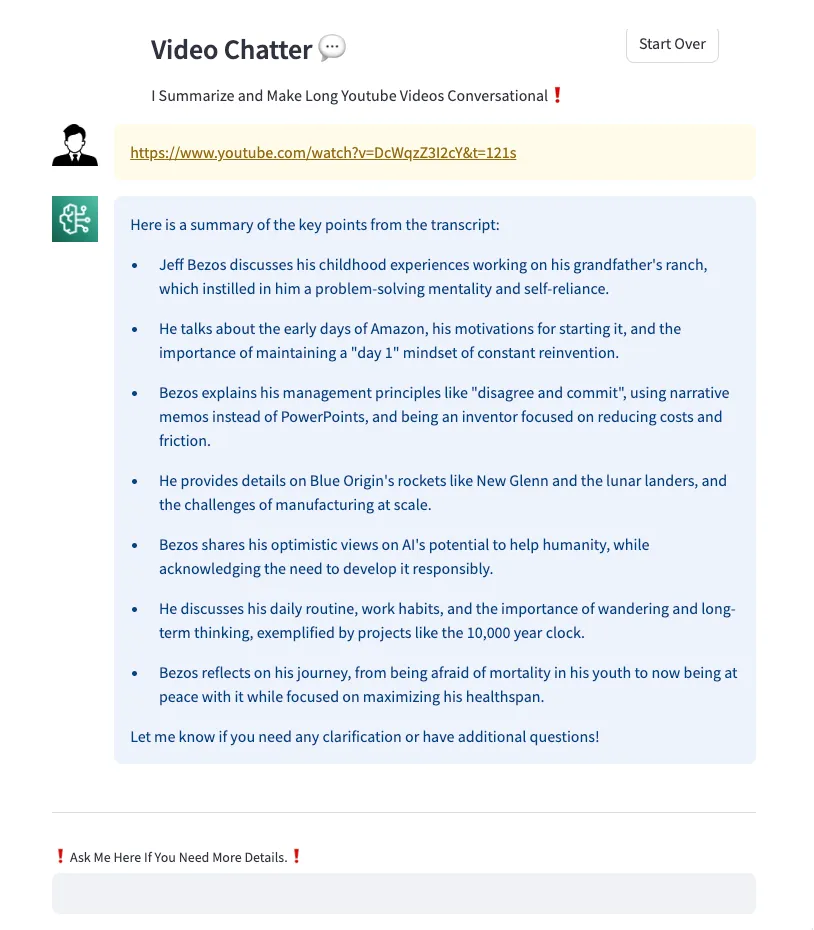How I Built a Video Chat App with almost Zero Code Writing
Building an GenAI based app to summarize videos and make them conversational without me almost writing any code.


- A user enters a YouTube video URL to summarize.
- The Streamlit app takes the URL, parses it to get the video ID, and calls the YouTube API to get the video transcript.
- The app builds a prompt from the transcript and passes it to Bedrock for summarization using a predefined model.
- Bedrock summarizes the transcript based on the generated prompt and returns the summary to the user.
- If users have follow-up questions, the app builds a conversation memory using Langchain and answers follow-up questions based on content from the original transcript.
- Set up access to Amazon Bedrock in the AWS region us-east-1 and set up model access for
Anthropic Claude 3. I’m using this LLM because it has a max token of 200k, which allows me to handle transcripts of videos up to 3 hours in length in the prompt without the complexity of adding a knowledge base. Check here for details. - Set up Amazon Q Developer extension with your favorite code IDE. Mine is VSC. I used this video.
- Familiarity with the Streamlit framework to deploy your Python application – it literally took a minute to publish it.
- bedrock.py: The code module that deals with the LLM, creates Bedrock runtime, summarizes, and deals with chat history using LangChain.
- utilities.py: A module that retrieves video transcripts and builds a prompt from it.
- app.py: The main app that interacts with users. It takes the video URL, returns the summary, allows chat, and deals with user sessions.
1
write a python function that sets up a conversational AI system using the Amazon Bedrock service and the Claude language model (claude3). The AI can engage in a back-and-forth conversation with a user, maintaining context and providing relevant responses based on the prompt template and conversation history and then return the conversation with the user.
1
2
3
4
5
6
7
8
9
10
11
12
13
14
15
16
17
18
19
20
21
22
23
24
25
26
27
28
29
30
31
32
33
34
35
36
37
38
39
40
41
42
43
44
45
46
47
48
49
50
51
52
53
54
55
56
57
58
59
import boto3
from langchain.prompts import PromptTemplate
from langchain.chains import ConversationChain
from langchain.memory import ConversationBufferMemory
from langchain_community.chat_models import BedrockChat
import streamlit as st
from botocore.config import Config
retry_config = Config(
region_name = 'us-east-1',
retries = {
'max_attempts': 10,
'mode': 'standard'
}
)
def bedrock_chain():
ACCESS_KEY = st.secrets["ACCESS_KEY"]
SECRET_KEY = st.secrets["SECRET_KEY"]
session = boto3.Session(
aws_access_key_id=ACCESS_KEY,
aws_secret_access_key=SECRET_KEY
)
bedrock_runtime = session.client("bedrock-runtime", config=retry_config)
model_id = "anthropic.claude-3-sonnet-20240229-v1:0"
model_kwargs = {
"max_tokens": 2048, # Claude-3 use “max_tokens” However Claud-2 requires “max_tokens_to_sample”.
"temperature": 0.0,
"top_k": 250,
"top_p": 1,
"stop_sequences": ["\n\nHuman"],
}
model = BedrockChat(
client=bedrock_runtime,
model_id=model_id,
model_kwargs=model_kwargs,
)
prompt_template = """System: TThe following is a video transcript. I want you to provide a comprehensive summary of this text and then list the key points. The entire summary should be around 400 word.
Current conversation:
{history}
User: {input}
Bot:"""
prompt = PromptTemplate(
input_variables=["history", "input"], template=prompt_template
)
memory = ConversationBufferMemory(human_prefix="User", ai_prefix="Bot")
conversation = ConversationChain(
prompt=prompt,
llm=model,
verbose=True,
memory=memory,
)
return conversation
- Get the YouTube ID from a YouTube URL
- Get the transcript of a video based on its ID
- Generate a prompt from the transcript
1
2
3
4
5
6
7
8
9
10
11
12
13
14
15
16
17
18
19
20
21
22
23
24
25
26
27
28
29
30
31
32
33
34
35
36
37
38
import logging
from youtube_transcript_api import YouTubeTranscriptApi
logger = logging.getLogger()
logger.setLevel("INFO")
def get_video_id_from_url(youtube_url):
logger.info("Inside get_video_id_from_url ..")
watch_param = 'watch?v='
video_id = youtube_url.split('/')[-1].strip()
if video_id == '':
video_id = youtube_url.split('/')[-2].strip()
if watch_param in video_id:
video_id = video_id[len(watch_param):]
logger.info("video_id")
logger.info(video_id)
return video_id
def get_transcript(video_id):
logger.info("Inside get_transcript ..")
transcript = YouTubeTranscriptApi.get_transcript(video_id)
logger.info("transcript")
logger.info(transcript)
return transcript
def generate_prompt_from_transcript(transcript):
logger.info("Inside generate_prompt_from_transcript ..")
prompt = "Summarize the following video:\n"
for trans in transcript:
prompt += " " + trans.get('text', '')
logger.info("prompt")
logger.info(prompt)
return prompthandle_input(), which detects the user input (whether it’s a URL to summarize or a follow-up question), returns output (summarization or answer in a chat), and resets user states accordingly.1
2
3
4
5
6
7
8
9
10
11
12
13
14
15
16
17
18
19
20
21
22
23
24
25
26
27
28
29
30
31
32
33
34
35
36
37
38
import logging
from youtube_transcript_api import YouTubeTranscriptApi
logger = logging.getLogger()
logger.setLevel("INFO")
def get_video_id_from_url(youtube_url):
logger.info("Inside get_video_id_from_url ..")
watch_param = 'watch?v='
video_id = youtube_url.split('/')[-1].strip()
if video_id == '':
video_id = youtube_url.split('/')[-2].strip()
if watch_param in video_id:
video_id = video_id[len(watch_param):]
logger.info("video_id")
logger.info(video_id)
return video_id
def get_transcript(video_id):
logger.info("Inside get_transcript ..")
transcript = YouTubeTranscriptApi.get_transcript(video_id)
logger.info("transcript")
logger.info(transcript)
return transcript
def generate_prompt_from_transcript(transcript):
logger.info("Inside generate_prompt_from_transcript ..")
prompt = "Summarize the following video:\n"
for trans in transcript:
prompt += " " + trans.get('text', '')
logger.info("prompt")
logger.info(prompt)
return promptAny opinions in this post are those of the individual author and may not reflect the opinions of AWS.
